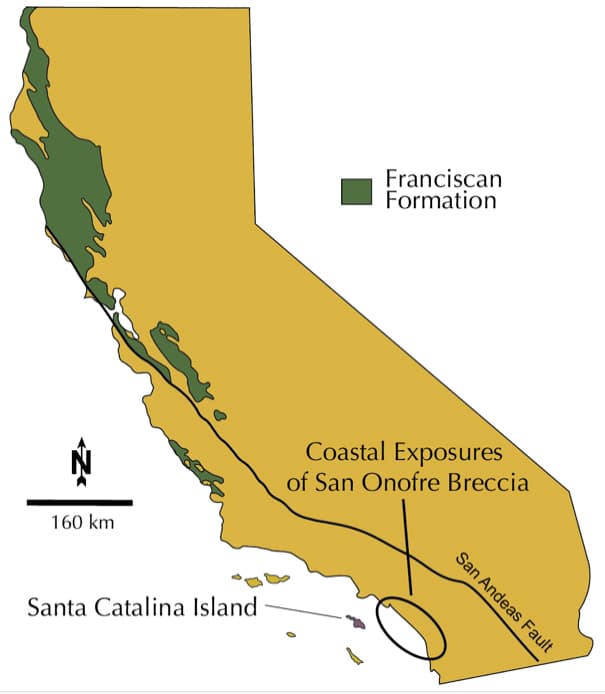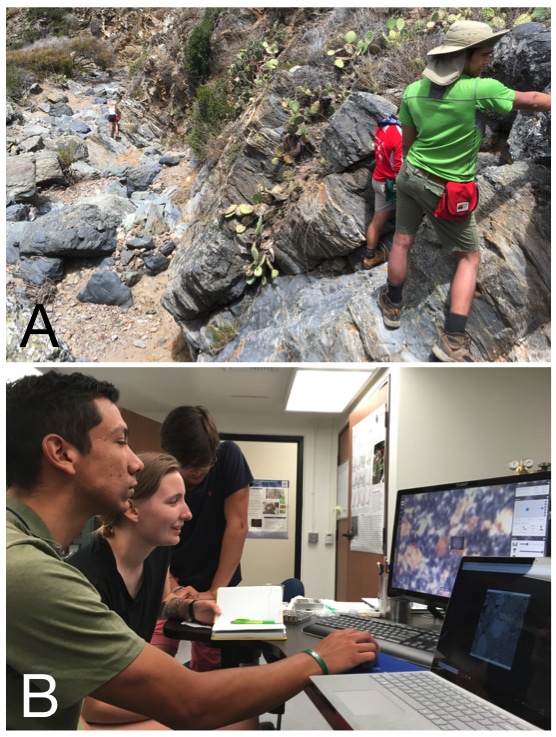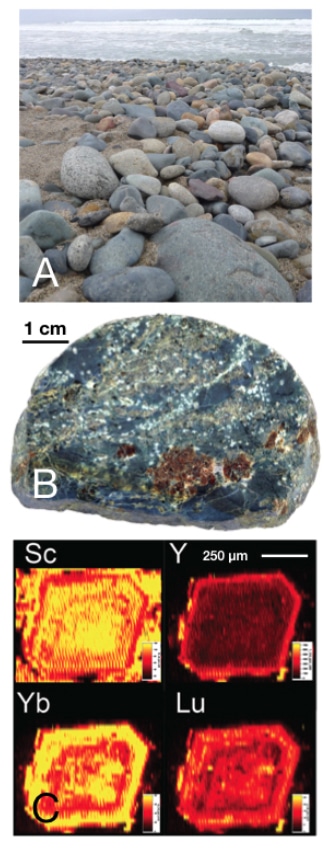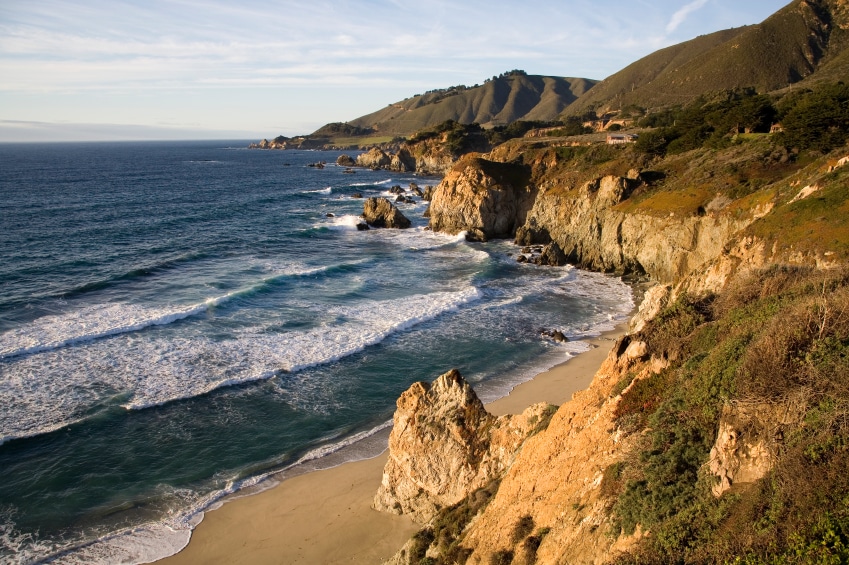How many California Mesozoic subduction cycles? 1, 2, or 3?
Overview: Mysterious blocks of garnet-bearing rock are found within sediments throughout coastal California. Although these rocks were clearly formed during subduction, their relationship to one another remains obscure. In the late Cretaceous period, western North America was an active subduction zone, much like the Cascades of current day Oregon and Washington. As the Pacific tectonic plate subducted under North America, vigorous magmatic “arcs” formed at the continental margin, forming volcanic chains at the surface and extensive batholiths in the subsurface. Those batholiths are exposed in California today as the Sierra Nevada and Peninsular Ranges. This magmatism was triggered as dense oceanic crust of the Pacific plated slid down into the mantle, which caused increasing pressure and temperature drive growth of new minerals in the slab, which released water and triggered extensive melting of the mantle. These mantle melts in turn fueled crustal melting in the bases of the magmatic arcs that induced additional crustal melting and reconstituted the crust above the arc. Jurassic and Triassic igneous rocks interspersed within the younger Cretaceous batholiths show that this was not the first cycle of subduction along the North American continental margin in the Mesozoic, but the details of the transitions between subduction cycles are elusive. After subduction ended, disruption of arc domains by the San Andreas Fault system defined the geologic collage that is defines the iconic landscapes of modern coastal California. Metamorphic rocks from the subduction zone itself offer the best possibility to reconstruct the pressure-temperature-time circumstances of subduction cycles. In coastal southern California, such rocks include the fragments of subduction mélange exhumed as the San Andreas system tore into the ancient subduction zone. In this process, small coastal basins that opened received some of the subduction detritus, but more intact slivers of it are exposed on Santa Catalina island, the Channel Islands, and farther north in the Franciscan Formation. Within the mélange and detritus of this ancient subduction zone, blueschists, greenschists, amphibolites, and eclogites show that a spectrum of pressure-temperature histories are preserved and as a whole can be used to probe the timing and structure of different cycles of subduction. This year’s subduction-focused project will give rising Seniors the opportunity to frame theses and other independent studies that use geochemical studies of different lithologic and mineral records that help shape our understanding of how subduction works.
When: June 16–July 15, 2020
Where: Oberlin College, OH (~1 week for orientation, optical and SEM petrography of eclogites and related rocks, frame project ideas), Pomona College, CA (~3 weeks to include coastal field work and on Catalina; lab work at Pomona; shipping samples to home institutions)
Who: Eight Students, Project Leaders Zeb Page (Oberlin College, zeb.page@oberlin.edu); Jade Star Lackey (Pomona College, JadeStar.Lackey@pomona.edu), and additional peer mentors
Prerequisites and Recommended Courses: Curiosity and excitement about tectonics as a driver of change on our planet. Ability to work collaboratively with others. Course work in Mineralogy or Earth Materials is essential. Course work in Petrology preferred. Experience in Sedimentology or Geochemistry are helpful. Applicants should be comfortable in both laboratory and field settings; in the field, individuals should be able to hike and carry personal effects and samples in a variety of field conditions. Some work may be conducted on outcrops on US Military bases and clearance may be requested.
Expectations and Obligations:
1. Participation in all project-related work from June 16-July 15, 2020. Commitment to work collaboratively in an environment of mutual respect including adhering to community standards of conduct in all parts of the project. These will be collectively developed at the beginning of the project.
2. Participants in the project should plan to use this work toward completion of a senior thesis (or equivalent) in geology.
3. Follow up data analysis at home institution and regular conference calls with research team throughout academic year.
4. Write an abstract and author or co-author a poster or talk at the American Geophysical Union meeting in San Francisco, CA (Dec 7–11, 2020).
5. Write a short contribution (4-6 pages text + figures) to be published in the Proceedings of the Keck Geology Consortium 2021 Volume (first draft due Mid-February).
PROJECT DESCRIPTION
Geologic Overview
High-pressure, garnet-bearing metamorphic rocks are found as blocks within mélange from the Franciscan Formation of Northern California, to Santa Catalina Island, south to Cedros Island off Baja California. Although they have all been the subject of substantial geochemical and petrologic study, few studies have set out to make direct comparisons between them.
The first descriptions of glaucophane and eclogite in California came from tectonic blocks hosted by the Franciscan Formation, were first reported near the turn of the 19th to 20th centuries, and included the original description of the iconic mineral lawsonite (Ransome, 1894; Becker, 1888; Holoway, 1904). When meter-scale blocks of garnet-bearing metamorphic rock hosted by mélange were recognized on Catalina in the first half of the twentieth century, it was only natural to ascribe them to the Franciscan Formation as well (Woodford, 1924). Likewise, contemporaneous work by Woodford (1925) established that the San Onofre Breccia (which grades from Breccia to Conglomerate) contained clasts of blueschists. These puzzling rocks were found in coastal exposures in Southern California. Woodford concluded that the clasts had been derived from a source that emerged above sea level in the Miocene (“Catalinia”) and could only have been sourced from the distinct glaucophane, amphibolite, and actinolite schists of Catalina Island. Woodford recognized problems with the transport distance and location of the Catalina source in his work; these problems were later resolved disruption of terranes by the San Andreas fault system.
The modern era of Catalina geology began with detailed mapping and a tectonic model by Platt (1975). The metamorphic rocks of Santa Catalina Island (sometimes referred to as the Catalina Schist) consist of mappable units of dominantly metasedimentary rock (including zones of mélange) that range from lawsonite-blueschist to amphibolite facies, with increasing grade correlated with structural height (Platt, 1975). The highest-grade amphibolite unit from Catalina records peak conditions of 7–-12 kbar and 650-750 °C based on cation thermometry and fluid inclusion barometry (Platt, 1975; Sorensen and Barton, 1987). The unusually high temperatures and Barrovian-like assemblages of the highest-grade rocks became the basis for the interpretation that the Catalina Schist was formed in a nascent subduction zone. In this model, the amphibolite-facies rocks were formed at the initiation of subduction and recorded high temperatures due to proximity with the hot mantle wedge; the inverted metamorphic gradient of underthrust lower-grade units recorded the subsequent cooling of the trench (Platt, 1975; Peacock, 1987). This model provided a mechanism for the formation of older hotter rocks now found in a lower-T mélange, and has been widely applied to both Catalina and the Franciscan (Anczkiewicz et al., 2004).

Figure 1: Geologic sketch map of California, modified from Bailey et a. (1964).

Figure 2: Field work on of a blueschist block on Santa Catalina Island (A). Picking ablation points on a garnet in the LA-ICP-MS lab.
However, the simple model of Catalina being a Franciscan equivalent formed during subduction initiation has begun to unravel. More recent analysis of detrital zircon ages from Catalina metasedimentary rocks has revealed that accretion of the Catalina Schist occurred over at least a 20 My period, with the lowest-grade units containing detrital zircons younger than the 115 Ma metamorphic age yielded by the high-grade rocks (Grove et al., 2008; Page et al., 2019). Franciscan blueschists (the lowest temperature blocks) typically record ages of ~140Ma, substantially older than the hotter rocks commonly found on Catalina (Mulcahy et al., 2009; Page et al., 2014). It seems that the bulk of the Catalina Schist was metamorphosed well after Franciscan blocks. Furthermore, a single garnet blueschist block (Fig. 2, Fig. 3 upper right) found in the blueschist-facies mélange yielded high-error Rb-Sr and Ar-Ar ages of ~150 Ma suggesting that a pre-Catalina subduction zone existed in the region. The age of the garnet blueschist block was firmly established by a 155±8 U-Pb sphene age collected during the 2012 Keck project (Awalt et al., 2013). Additional petrographic and trace element work on this key sample conducted during the 2018 Keck project has demonstrated the lawsonite in this sample is texturally late, and forms veins that cross-cut garnet, suggesting a history of high-P/T polymetamorphism that is common in the Franciscan (e.g., Moore, 1984; Mulcahy et al., 2018) but otherwise unknown on Catalina. (Adler-Ivanbrooke et al., 2018). It seems that Catalina Island may contain remnants of both Franciscan subduction, and a later, 115Ma Catalina subduction zone.
The last 40 to 50 years has seen substantial growth in our understanding of both the Franciscan and Catalina Island, but the same cannot be said for the petrology of clasts within the San Onofre Breccia. Stratigraphic and sedimentological evidence point to a highlands origin to the west, dubbed “Catalinia” (Stuart, 1979). Detailed petrologic work is restricted to one Pomona College undergraduate thesis (Sorensen, 1978). We propose to fill this gap with eight student projects in a Focused Keck Project. Are the high-pressure clasts of the San Onofre Breccia of Franciscan or Catalinian origin, or altogether different in origin (Fig.3)? We propose to apply modern petrological techniques of in situ major, trace element, and isotopic microanalysis coupled with thermodynamic modelling to provide the first metamorphic histories of San Onofre Clasts, and tie them more directly to current understandings of the Francisan and Catalina Schist Terranes.

Figure 3: A) Blueschist cobbles from the San Onofre Breccia at the type locality; B) Slabbed garnet blueschist cobble. C) Discontinuous trace element zoning in garnet crystal from blueschist block on Catalina Island showing episodic growth stages.
Study Sites & Methods
Initial lab work will focus on previously prepared thin sections of Franciscan and Catalina rocks and a literature review and discussion. Students will be introduced to the geologic problems we will be addressing while beginning to do optical and SEM petrography on initial samples. This approach worked well in our 2018 Gateway Project; however, rather than using the time to introduce basic petrologic concepts to students, we will focus on beginning to learn more advanced techniques (e.g., thermodynamic modelling) and on allowing students to design their own projects and plan their own sampling. Field work in Los Angeles will have two main foci. On Catalina, we will look for more “exotic” blocks (such as the Franciscan-aged blueschist) guided by fieldwork completed in 2012 and 2018. On the mainland we will visit numerous exposures of the SOB along the coast south of Los Angeles. We will attempt to negotiate access to classic exposures on the Camp Pendleton Marine Base (Sorensen, 1978), however there are many other easily accessible localities along public beaches. We will aim to collect representative samples of breccia clasts, make a survey of different lithological abundances based on field observations, and sample finer-grained matrix for detrital minerals. Because the San Onofre Breccia is commonly overlain by the Miocene Monterey Formation, which is rich in hydrocarbons and one of the most famous sedimentary formations in California, it is common that the Breccia is accidentally sampled during drilling exploration for petroleum plays. Thus, we intend to arrange with students a trip to the CRC Petroleum (a Pomona Geology alumnus works at the company) to examine core and also collect samples parts of buried San Onofre Breccia. Prof. Lackey has secured access to over a dozen cores from CRC that reach San Onofre Breccia at depths of 6,000-10,000 feet in the Los Angeles Basin.
Student Projects
Below is a list of projects that we will encourage students to modify as appropriate to make their own. Students will work on materials collected from Catalina and the SOB during the second half of the project, and also on samples previously collected from other Keck projects and Page’s work in the Franciscan.
Quantitative Thermobarometry
Students will begin descriptive work on prepared samples in the opening days of the project, looking for similarities and differences between blueschists. Thermodynamic modelling of metamorphic assemblages using Perple_X (Connolley, 2005) will also be undertaken in groups to introduce the techniques and get preliminary quantitative P-T data for these samples. Up to three students may choose to expand this approach over the coming year, applying it to new samples collected from either the SOB or Catalina, or both. Bulk compositions to use as inputs to the modelling package can be derived from phase maps made by SEM at Oberlin, or XRF analyses performed at Pomona. We anticipate three distinct projects within this thread of the work that are either compositionally or geographically defined based on outcrop exposures.
Rutile and Sphene Thermometry and Trace Element Geochemistry
Rutile and sphene are ubiquitous phases of the SOB in clasts and the sandy matrix as well in blocks on Catalina. Rutile temperatures from Catalina are in general higher than in Franciscan blocks (Penniston-Dorland et al., 2018) and results from the SOB can be compared to published data and new data collected at Pomona. Students working on these projects can “cross-pollinate” with those working on thermodynamic modelling of the same samples in order to make comparison of conditions of metamorphism recorded by the different techniques. Suites of detrital rutile from the SOB matrix can be analyzed for thermometry and trace elements (e.g., Cr, Nb) for comparison with Catalina and Franciscan samples (e.g., Pereira et al., 2019). Because the SOB is thought to be the result of the uplift and unroofing of Catalinia, a test of the relative “depth” into the Catalina schist during erosion might be informed by the temperatures of detrital metamorphic minerals. Samples from drill cores may prove especially useful for providing stratigraphic sampling that is proximal and distal to Catalinia. Three projects in this research theme are planned, being mineralogically defined, or again by geographic/stratigraphic scope.
U-Pb Geochronology
Detrital rutile, sphene, and zircon and those found within tectonic blocks and cobbles are all potential targets for U-Pb geochronology. We are cautiously excited about this possibility, and we will test its feasibility on grain mounts collected for this purpose. However, Franciscan eclogite and blueschist have notoriously low U contents in rutile and sphene (Mattinson, 1986). This research thrust is intended to support two student projects.
PROJECT LOGISTICS
The first week to 10 days will be spent on campus at Oberlin College. We will immerse ourselves into the relevant scientific literature and collect major element data on samples from some drill core material and those collected in 2012 and 2018 on the SEM/EDS. The new Tescan-Oxford system at Oberlin can collect data in an automated fashion overnight, and students will spend time using the instrument in the afternoons and “data mining” maps collected overnight.
The group will travel to Los Angeles together, and establish a new base at Pomona College. Field work on the SOB will be done as day-trips from Pomona (or possibly camping at the San Onofre State Park Campground to avoid problems with traffic). We anticipate the second week of the project to be a blend of sample collection and lab work on the San Onofre samples.
Time on Catalina (4-6 days) will start with and island overview field trip to get the lay of the land. We will visit the outcrops that were sampled previously to talk about sampling strategy, and take a second round of samples informed by the observations already made by the students in the lab. Finally, there are several mélange units with blocks described in the Catalina literature of the 1970’s and 80’s (e.g., Pomona alumna Sorena Sorensen, 1986) that have not been worked on more recently, and we will take two days to do some reconnaissance work on the SW side of the island, in part to acquaint the students of how to approach a new field area (as opposed to a more guided field trip). The proposed field area is part of the 88% of Catalina Island that is privately owned and managed by the Catalina Island Conservancy. Private motor vehicles are not allowed, and all research must be permitted by the Conservancy. An extension of Page’s permit is straightforward to obtain, and we have already started this process. Last year the Conservancy provided camping and transportation support, and will again for this field season. Field equipment (Hammers, Bruntons, Trimble GeoXT handheld GPS receivers for detailed mapping) will be provided by Oberlin, and Pomona Colleges. As part of our orientation on the island, Conservancy staff will give us an overview of the important biological (a rare, undeveloped island ecosystem 25 miles from downtown LA) and cultural (7000 years of pre-colonial habitation by the Tongva people) aspects of Catalina.
The final 1.5 weeks will be spent on campus at Pomona. There students will become familiarized with the LA-ICPMS system, including methods of standardization, data reduction, and evaluation of data quality. They will analyze rutile and other minerals already identified at Oberlin, and separated at Pomona from newly collected samples and reduce and correct trace element data. Teams of students will rotate between ICP-MS work, preparation of XRF beads for whole rock chemistry, and interpretation of data. They will begin drafting group abstracts and posters, and planning the work they will undertake at their home institutions. We have also included sufficient analytical time in the budget that will allow students to continue collecting data into the fall remotely from Pomona and Oberlin on grain mounts prepared in the summer.
PROFESSIONAL DEVELOPMENT
Communicating Science: We plan workshops participants on writing abstracts, making posters, and presenting posters while they are at Oberlin and Pomona. They will practice these skills at AGU (see below).
Skills Workshops: While at Oberlin, students will participate in skills workshops focused on developing essential quantitative skills, including but not limited to using Excel, making figures, reading papers and textbooks, and taking field notes (prior to going in the field, of course). When possible, we will work with Nicollette Mitchell (a Keck alumna), who runs Oberlin’s Summer Research Institute to integrate the Keck students into their programming.
Attending a meeting: Because we anticipate that students will acquire a significant amount of preliminary data, in support of their individual research projects, it is our goal to enable students to complete abstracts that they can submit near the end of the project for attending the American Geophysical Union meeting in San Francisco in December, 2020. Students will be provided with funds to attend AGU. At AGU we will mentor students in how to decide what talks and posters to attend, good ways to interact with presenters at poster sessions, how to present their work, and what other events are good to attend.
References
Adler-Ivanbrook B, Hampton SK, Esparza Limon JP, Lackey JS, and Page FZ (2018) An investigation of the Catalina garnet-blueschist: Major and trace element composition and zoning in garnet and lawsonite from a multiply subducted block, Abstract T21F-0290 presented at 2018 AGU Fall Meeting, Washington, DC 10-14 Dec.
Anczkiewicz, R., Platt, J.P., Thirlwall, M., Wakabayashi, J., 2004. Franciscan subduction off to a slow start: evidence from high-precision Lu–Hf garnet ages on high grade-blocks. Earth and Planetary Science Letters 225, 147–161.
Awalt, M.B., Page, F.Z., Walsh, E.O., Kylander-Clark, A.R.C., Wirth, K.R., 2013. New evidence for old subduction in the Catalina Schist, Santa Catalina Island, CA. Geological Society of America Abstracts with Programs 45, 798.
Becker, G.F., 1888, Geology of the quicksilver deposits of the Pacific slope, with an atlas: Washington, D.C., US Government Printing Office, v. 13, 486 p.
Connolly, J.A.D., 2005. Computation of phase equilibria by linear programming: A tool for geodynamic modeling and its application to subduction zone decarbonation. Earth and Planetary Science Letters 236, 524–541.
Grove, M., Bebout, G.E., Jacobson, C.E., Barth, A.P., Kimbrough, D., King, R.L., Zou, H., Lovera, O., Mahoney, B., Gehrels, G.E., 2008. The Catalina Schist: Evidence for middle Cretaceous subduction erosion of southwestern North America. GSA Special Paper 436, 335–361.
Holway, R.S., 1904, Eclogites in California: The Journal of Geology v. 12, p, 344–358.
Mattinson, J.M., 1986. Geochronology of high-pressure-low-temperature Franciscan metabasites: A new approach using the U-Pb system. Geological Society of America Memoir 164, 95–106.
Moore, D.E., 1984. Metamorphic History of a High-Grade Blueschist Exotic Block from the Franciscan Complex, California. Journal of Petrology 25, 126. doi:10.1093/petrology/25.1.126
Mulcahy, S.R., King, R.L., Vervoort, J., 2009. Lawsonite Lu-Hf geochronology: A new geochronometer for subduction zone processes. Geology 37, 987–990. doi:10.1130/G30292A.1
Mulcahy, S.R., Starnes, J.K., Day, H.W., Coble, M.A., Vervoort, J., 2018. Early Onset of Franciscan Subduction. Tectonics 37, 1194–1209. doi:10.1029/2017TC004753
Page, F.Z., Essene, E.J., Mukasa, S.B., Valley, J.W., 2014. A garnet-zircon oxygen isotope record of subduction and exhumation fluids from the Franciscan Complex, California. Journal of Petrology 55, 103–131.
Page, F.Z., Cameron, E.M., Flood, C.M., Dobbins, J.W., Spicuzza, M.J., Kitajima, K., Strickland, A., Ushikubo, T., Mattinson, C.G., Valley, J.W., 2019. Extreme oxygen isotope zoning in garnet and zircon from a metachert block in mélange reveals metasomatism at the peak of subduction metamorphism. Geology 47, 655–658. doi:10.1130/G46135.1
Peacock, S., 1987. Creation and Preservation of Subduction-Related Inverted Metamorphic Gradients. J Geophys Res-Solid 92, 12763–12781.
Penniston-Dorland, S.C., Kohn, M.J., Piccoli, P.M., 2018. A mélange of subduction temperatures: Evidence from Zr-in-rutile thermometry for strengthening of the subduction interface. Earth and Planetary Science Letters 482, 525–535. doi:10.1016/j.epsl.2017.11.005
Pereira, I., Storey, C.D., Darling, J., Lana, C., Alkmim, A.R., 2019. Two billion years of evolution enclosed in hydrothermal rutile: Recycling of the São Francisco Craton Crust and constraints on gold remobilisation processes. Gondwana Research 68, 69–92. doi:10.1016/j.gr.2018.11.008
Platt, J.P., 1975. Metamorphic and deformational processes in the Franciscan Complex, California: some insights from the Catalina Schist terrane. Bulletin of the Geological Society of America 86, 1337–1347.
Ransome, F.L., 1894. On Lawsonite, a new rock-forming mineral from the Tiburon Pensinsula, Marin County, California. University of California Bulletin of the Department of Geology 1, 301–312.
Sorensen, S.S., Barton, M., 1987. Metasomatism and Partial Melting in a Subduction Complex – Catalina Schist, Southern-California. Geology 15, 115–118.
Sorensen, S.S., 1978. Petrology of San Onofre Breccia “Megaclasts”, San Onofre Mountain, California. Undergraduate Thesis, Pomona College, 77p.
Stuart, C.J., 1979, Lithofacies and origin of the San Onofre Breccia, Coastal Southern California, A Guide to Miocene Lithofacies and Depositional Environments, coastal southern California, Coastal Southern California and Northwestern Baja California: Pacific Section SEPM, p. 25–42.
Woodford, A.O., 1924. The Catalina metamorphic facies of the Franciscan Series. University of California Publications in Geological Sciences 15, 49–68.
Woodford, A.O., 1925, The San Onofre Breccia, Its Nature and Origin: Berkeley, California, University of California Press, 280 p.

